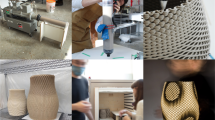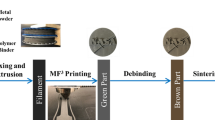Abstract
Weathering, an expression of degradation caused by rain and wind, is essential for photorealistic computer graphics. One of the commonest targets of weathering is metal, which is omnipresent in reality. However, for the realistic reproduction of scenes, many of which display degradation, the application of rust-proof paint to metal surfaces cannot be ignored. In our study, we propose a weathering method for coated films on metal objects, which are modeled using a three-dimensional (3D) triangular polygon mesh and deformed by combining two kinds of simulations: static simulation, for determining fractures based on the balance of the internal forces, and position-based bend simulation for moving vertices according to geometric constraints. Our method can digitally reproduce the deterioration of coated films using complex 3D deformation, which is difficult to achieve by material manipulation only.


















Similar content being viewed by others
Data availability
The data related to this study are available from the corresponding author upon request.
References
Bellini, R., Kleiman, Y., Cohen-Or, D.: Time-varying weathering in texture space. ACM Trans. Gr. 35(4), 141:1-141:11 (2016)
Bender, J., Koschier, D., Charrier, P., Weber, D.: Position-based simulation of continuous materials. Comput. Gr. 44, 1–10 (2014)
Chang, Y.X., Shih, Z.C.: The synthesis of rust in seawater. Vis. Comput. 19(1), 50–66 (2003)
Chen, H.Y., Sastry, A., van Rees, W.M., Vouga, E.: Physical simulation of environmentally induced thin shell deformation. ACM Trans. Gr. 37(4), 146:1-146:13 (2018)
Chen, Y., Xia, L., Wong, T.T., Tong, X., Bao, H., Guo, B., Shum, H.Y.: Visual simulation of weathering by \(\gamma \)-ton tracing. In: Proceedings of ACM SIGGRAPH 2005, pp. 1127–1133 (2005)
Desbenoit, B., Galin, E., Akkouche, S.: Modeling cracks and fractures. Vis. Comput. 21(8), 717–726 (2005)
Dorsey, J., Hanrahan, P.: Modeling and rendering of metallic patinas. In: Proceedings of the 23rd annual conference on computer graphics and interactive techniques, pp. 387–396 (1996)
Gobron, S., Chiba, N.: Simulation of peeling using 3D-surface cellular automata. In: Proceedings of the 9th Pacific conference on computer graphics and applications, pp. 338–347 (2001)
Iizuka, S., Endo, Y., Kanamori, Y., Mitani, J.: Single image weathering via exemplar propagation. Comput. Gr. Forum 35(2), 501–509 (2016)
Ishitobi, A., Nakayama, M., Fujishiro, I.: Visual simulation of weathering coated metallic objects. Vis. Comput. 36(10), 2383–2393 (2020)
Jain, N., Kalra, P., Kumar, S.: Simulation and rendering of pitting corrosion. In: Proceedings of the 2014 Indian conference on computer vision graphics and image processing, pp. 38:1–38:8 (2014)
Jeong, S., Kim, T.H., Kim, C.H.: Shrinkage, wrinkling and ablation of burning cloth and paper. Vis. Comput. 27(6), 417–427 (2011)
Jeong, S., Park, S.H., Kim, C.H.: Simulation of morphology changes in drying leaves. Comput. Gr. Forum 32(1), 204–215 (2013)
Kelager, M., Niebe, S., Erleben, K.: A triangle bending constraint model for position-based dynamics. In: Proceedings of the 7th workshop in virtual reality interactions and physical simulation, pp. 31–37 (2010)
Kimmel, B.W., Baranoski, G.V.G., Chen, T.F., Yim, D., Miranda, E.: Spectral appearance changes induced by light exposure. ACM Trans. Gr. 32(1), 10:1-10:13 (2013)
Kratt, J., Spicker, M., Guayaquil, A., Fiser, M., Pirk, S., Deussen, O., Hart, J.C., Benes, B.: Woodification: user-controlled cambial growth modeling. Comput. Gr. Forum 34(2), 361–372 (2015)
Merillou, S., Dischler, J.M., Ghazanfarpour, D.: Corrosion: Simulating and rendering. In: Proceedings of the graphics interface 2001 conference, pp. 167–174 (2001)
Mérillou, S., Ghazanfarpour, D.: A survey of aging and weathering phenomena in computer graphics. Comput. Gr. 32(2), 159–174 (2008)
Müller, M., Heidelberger, B., Hennix, M., Ratcliff, J.: Position based dynamics. J. Vis. Commun. Image Represent. 18(2), 109–118 (2007)
O’Brien, J.F., Hodgins, J.K.: Graphical modeling and animation of brittle fracture. In: Proceedings of the 26th annual conference on computer graphics and interactive techniques, pp. 137–146 (1999)
Muñoz Pandiella, I., Bosch, C., Mérillou, N., Patow, G., Mérillou, S., Pueyo, X.: Urban weathering: interactive rendering of polluted cities. IEEE Trans. Visual Comput. Gr. 24(12), 3239–3252 (2018)
Paquette, E., Poulin, P., Drettakis, G.: The simulation of paint cracking and peeling. In: Proceedings of the graphics interface 2002 conference, pp. 59–68 (2002)
Perlin, K.: Improving noise. ACM Trans. Gr. 21(3), 681–682 (2002)
Silling, S.: Reformulation of elasticity theory for discontinuities and long-range forces. J. Mech. Phys. Solids 48(1), 175–209 (2000)
Stomakhin, A., Schroeder, C., Chai, L., Teran, J., Selle, A.: A material point method for snow simulation. ACM Trans. Gr. 32(4), 102:1-102:10 (2013)
Stoney, G.G.: The tension of metallic films deposited by electrolysis 82(553), 172–175 (1909)
Tanabe, R., Moriya, T., Morimoto, Y., Takahashi, T.: A generation method of rust aging texture considering rust spreading. In: Proceedings of international workshop on advanced image technology, pp. 399:1–399:4 (2015)
Turner, M.J., Clough, R.W., Martin, H.C., Topp, L.J.: Stiffness and deflection analysis of complex structures. J. Aeronaut. Sci. 23(9), 805–823 (1956)
Wang, J., Tong, X., Lin, S., Pan, M., Wang, C., Bao, H., Guo, B., Shum, H.Y.: Appearance manifolds for modeling time-variant appearance of materials. ACM Trans. Gr. 25(3), 754–761 (2006)
Xue, S., Dorsey, J., Rushmeier, H.: Stone weathering in a photograph. In: Proceedings of the 22nd eurographics conference on rendering, pp. 1189–1196 (2011)
Xue, S., Wang, J., Tong, X., Dai, Q., Guo, B.: Image-based material weathering. Comput. Gr. Forum 27, 617–626 (2008)
Acknowledgements
This work has been supported in part by JSPS KAKENHI under the Grant-in-Aid for Scientific Research (A) No. 21H04916 and Grant-in-Aid for JSPS Fellows No. 21J21729.
Author information
Authors and Affiliations
Corresponding author
Ethics declarations
Conflict of interest
The authors declare that they have no conflict of interest.
Additional information
Publisher's Note
Springer Nature remains neutral with regard to jurisdictional claims in published maps and institutional affiliations.
Supplementary Information
Below is the link to the electronic supplementary material.
Supplementary file 1 (mp4 39110 KB)
Appendix
Appendix
We apply the triangle bending constraint in [14] to describe an angle constraint as a combination of simple length constraints to achieve high-quality simulations with fast convergence. As shown in Fig. A1a, a triangle bending constraint controls the angle formed by two connected edges by setting a length constraint on the distance between the center of the triangle, which has the two edges as sides, and the junction point of the edges.
Figure A1b shows a tetrahedron bending constraint, which controls the angle formed by two adjacent faces. A tetrahedron bending constraint sets a length constraint on the distance between the center of a tetrahedron, which has the two faces as surfaces, and the edge shared by the faces. Notice we assume that each polygon has a shape similar to an equilateral triangle and the distance is equal to the distance between the center and midpoint of the edge. If the ends of the edges are \(\varvec{p}_1, \varvec{p}_2\) and the other vertices are \(\varvec{p}_3, \varvec{p}_4\), the middle point of the edge \(\varvec{v}\) and the center of the tetrahedron \(\varvec{c}\) are given as:
Therefore, if the target value of the distance between \(\varvec{v}\) and \(\varvec{c}\) is \(d_0\), the tetrahedron bending constraint \(C_{\textrm{tetrahedron}}\) is described as:
However, similar to the angle constraints described in Sect. 4.3, tetrahedron bending constraints must also be divided to distinguish between mountain and valley folds (Fig. A2). Given \(l^1=\Vert \varvec{v}-\varvec{p}_3\Vert , l^2=\Vert \varvec{v}-\varvec{p}_4\Vert \), the target value of the angle \({\phi }_0\; (0<\phi _0<2\pi )\), and the positions on the neutral axis \(\varvec{v}^1=\varvec{v}+l^1\varvec{n}_{\textrm{neutral}},\varvec{v}^2=\varvec{v}+l^2\varvec{n}_{\textrm{neutral}}\), two tetrahedron bending constraints \(C_{\textrm{tetrahedron}}^1\) and \(C_{\textrm{tetrahedron}}^2\) are defined as:
where the constraint offsets \(d^1\) and \(d^2\) are given as:
Because \(\varvec{v}_1, \varvec{v}_2\) are virtual points, their inverse masses are set to 0. Let \(\varDelta \varvec{p}_1^1, \varDelta \varvec{p}_2^1\), and \(\varDelta \varvec{p}_3^1\) be the corrections for \(\varvec{p}_1, \varvec{p}_2\), and \(\varvec{p}_3\) according to \(C_{\textrm{tetrahedron}}^1\), and let \(\varDelta \varvec{p}_1^2, \varDelta \varvec{p}_2^2\), and \(\varDelta \varvec{p}_4^2\) be the corrections for \(\varvec{p}_1, \varvec{p}_2\), and \(\varvec{p}_4\) according to \(C_{\textrm{tetrahedron}}^2\), respectively. If the inverse mass of \(\varvec{p}_i\) is denoted as \(w_i\) and the sums of the inverse masses \(W=w_1+w_2+w_3+w_4\), \(W^1=W-w_4\), and \(W^2=W-w_3\) are defined, then Eq. (3) yields corrections for the positions, given as:
where strains \(u^1\) and \(u^2\) are given as:
Considering that the ratio of corrections is equal to the ratio of the inverse mass if the constraint is not divided, we represent the corrections \(\varDelta \varvec{p}_1, \varDelta \varvec{p}_2, \varDelta \varvec{p}_3\), and \(\varDelta \varvec{p}_4\) as follows:
Rights and permissions
Springer Nature or its licensor (e.g. a society or other partner) holds exclusive rights to this article under a publishing agreement with the author(s) or other rightsholder(s); author self-archiving of the accepted manuscript version of this article is solely governed by the terms of such publishing agreement and applicable law.
About this article
Cite this article
Ishitobi, A., Nakayama, M. & Fujishiro, I. Visual simulation of crack and bend generation in deteriorated films coated on metal objects: Combination of static fracture and position-based deformation. Vis Comput 39, 3403–3415 (2023). https://doi.org/10.1007/s00371-023-03029-z
Accepted:
Published:
Issue Date:
DOI: https://doi.org/10.1007/s00371-023-03029-z






